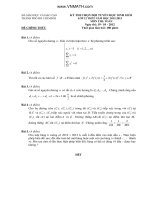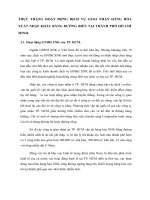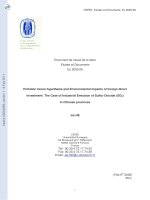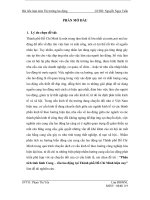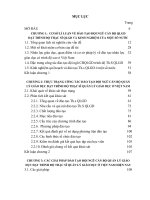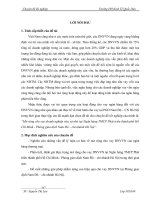- Trang chủ >>
- THPT Quốc Gia >>
- Toán
Do oil rents deter foreign direct investment? The case of Saudi Arabia - TRƯỜNG CÁN BỘ QUẢN LÝ GIÁO DỤC THÀNH PHỐ HỒ CHÍ MINH
Bạn đang xem bản rút gọn của tài liệu. Xem và tải ngay bản đầy đủ của tài liệu tại đây (913.07 KB, 7 trang )
<span class='text_page_counter'>(1)</span><div class='page_container' data-page=1>
<b>International Journal of Energy Economics and </b>
<b>Policy</b>
ISSN: 2146-4553
available at http: www.econjournals.com
<b>International Journal of Energy Economics and Policy, 2021, 11(1), 212-218.</b>
<b>Do Oil Rents Deter Foreign Direct Investment? The Case of </b>
<b>Saudi Arabia</b>
<b>Mohammad Imdadul Haque*</b>
Department of Management, College of Business Administration, Prince Sattam Bin Abdulaziz University, Saudi Arabia.
*Email:
<b>Received:</b> 20 July 2020 <b>Accepted:</b> 24 October 2020 <b>DOI:</b> /><b>ABSTRACT</b>
The relationship between foreign direct investments (FDI) and natural resource endowment of a country is contentious. This study attempts to study
this relationship for Saudi Arabia that is primarily an oil-producing country. In the process, it would also assess the role of institutions, trade openness,
and domestic investments in attracting FDI. Using the methodology of cointegration over the data for the period 1984-2016, the study ascertains the
presence of “resource curse” in terms of attracting FDI. The study discovers new findings as to the resource curse in attracting FDI are not because of
institutional quality which has a positive relationship with FDI. The results also indicate the absence of crowding out of domestic investments. Finally,
the study recommends channeling FDI to Greenfield projects with the maximum transfer of management and technology.
<b>Keywords:</b> Natural Resource, Institutions, Trade Openness, Crowding-out, Cointegration
<b>JEL Classifications:</b> E02; F21; O43; P33
<b>1. INTRODUCTİON</b>
Foreign direct investment (FDI) is a “lasting interest” in a venture
of another country. They are significant sources of capital for the
host economies. It is different from simple capital inflows and is
less prone to the crisis as there is a long-term association, there is
the technological transfer, management control, and risk-sharing.
</div>
<span class='text_page_counter'>(2)</span><div class='page_container' data-page=2>
may have a limited impact on the extraction sector in “Enclave
economies.” However, this may not be the case for Saudi Arabia as
the entire oil sector industry is in government-controlled. Also, FDI
may crowd out domestic investment. But, no evidence of crowding
out is found in Saudi Arabia as FDI is mostly capital intensive and
mainly in Saudi-owned joint ventures (Ramady and Saee, 2007).
Figure 1 provides a graphical representation of FDI inflows a
percentage of the country’s GDP. FDI inflows as a percentage of
GDP ranged between a maximum of 8.49% and −1.36% with an
average of 1.55%. There are lot of fluctuations in the FDI inflows
and is continuously declining after reaching its maximum in
2009. The country is constantly trying to diversify and reform
its economy particularly with the implementation of the National
Transformation Plan (2020) announced in 2016. Attracting FDI is
one of its strategic objectives. To increase FDI from SR30 billion
to SR70 billion is one of the targets of this plan. Saudi Arabian
General Investment Authority (SAGIA), the regulatory authority,
recently in 2018 removed four more items from the prohibited list
namely recruitment, media, real estate, and road transportation
services.
This study identifies the controversial rent-seeking nature of an
oil-exporting country like Saudi Arabia as a probable problem
which may disrupt the allocation of resources’, leading to a fall
in productive activities resulting in a reduction in economic
efficiency which is detrimental to economic efficiency. This can
discourage FDI inflows. The aim of this study is to assess whether
the adverse economic cost related to abundant natural resource
endowment affects the inflow of FDI. Towards this, the study tests
the hypothesis of whether oil rents, institutional quality, domestic
investments, and trade openness significantly impact FDI.
<b>2. LITERATURE REVIEW</b>
Dunning (1980) is of the opinion that natural resources attract
resource seeking FDI. Economies with high growth rates, a
business-friendly environment, and a greater percentage of
international trade attract more FDI (Elimam, 2017). But the role
of institutions plays a critical role in natural resource-rich countries
(Sachs and Warner, 1995; Haque, 2020). Besides convention
factors like GDP, trade openness, inflation, exchange rate, and
likewise, institutional quality has a critical role in attracting FDI,
particularly in oil-rich countries. Also, non-diversified and oil-rich
economies may sense FDI as a threat to economic sovereignty
and hence set many local ownership restrictions (Lopez-Carlos
and Schwab, 2007).
Abdel-Rahman (2007) studied the determinants of FDI for Saudi
Arabia for the period 1958-2000. The manufacturing sector
comprising of the petrochemical sector was the largest recipients
of FDI. The study found GDP and socio-political risk has positively
a significant impact on FDI. But, exports, domestic investments,
had a negative impact on FDI. The results implied that FDI had
a “crowding-out” effect on domestic investments indicating a
probable “crowding-out” effect. Also, as the variable sociopolitical
risk was significant it validates the inference that FDI tends to
increase because of lower risk in the country. The socio-political
factors were the indictors of ICRG. Other factors attracting FDI
were wage rates and the cost of capital.
Mina (2007) studied the reasons for FDI flows to the GCC
countries, for the period 1980-2002. The results indicated that
oil reserves, oil prices, and oil production, had discouraged FDI
inflows, nevertheless, oil production relative to oil reserves, which
measure the relative degree of oil utilization encouraged FDI.
The study further found that institutional quality, infrastructure,
and trade openness have a positive relationship with FDI while
human capital had a negative relationship with FDI. Rule of law
indicator of ICRG is used as a proxy for institutions. The study
laments declining FDI flows to these countries in spite of their
awareness to diversify the economy and income.
Khayat (2017) studied the location determinant of FDI in MENA
countries including Saudi Arabia for the period 1960-2012. Except
for fuel exports, the other proxies of natural resources like oil
rents, oil reserves, oil production, and oil production relative
to oil reserves had a negative relationship with FDI. The study
also looked into the interaction between these indicators with
Institutional quality proxy by the Investment profile of ICRG. The
interaction term between natural resources and investment profiles
also had a negative impact on FDI as natural resources diluted the
<b>Figure 1:</b> Foreign direct investment inflows
</div>
<span class='text_page_counter'>(3)</span><div class='page_container' data-page=3>
positive effects of institutions. Other variables like trade openness,
GDP, inflation, and investment profile had a positive impact on
FDI. Infrastructure and human did not impact FDI inflows.
Yazdanian (2014) studied the determinants for 14 oil-producing
countries including Saudi Arabia for the period 1986 and 2007.
It found GDP, oil production, and trade openness, and oil
production has a significant and positive impact on FDI while
the impact of oil price, exchange rate, and the inflation rate was
negative and significant. The study justified the increase of FDI
with an increase in oil production stating reasons that increase in
production requires more investments and transfer of technology
to the extraction and processing sector. The study justified the fall
in FDI with an increase in oil prices stating increases the revenues
of the exporting country discouraging the inflow of FDI.
Gawad and Muramalla (2013) find a positive relationship between
crude oil production and FDI for UAE, Kuwait, and Saudi Arabia.
The study finds different results for different oil crude oil-related
parameters and their relationship with FDI. First, the product of
oil is significantly related to FDI for UAE but not for Kuwait and
Saudi Arabia. The refinery capacity is significantly related to Saudi
Arabia but not to the UAE and Kuwait. And third, the export of
crude oil is significantly related to none of these three countries.
Rogmans and Ebbers (2013) in their study on OPEC countries
including Saudi Arabia for the period 1987-1997, oil price and
GDP per capita, and manufacturing exports are found to be
significant determinants of FDI, while the variable composite
risk and oil and gas reserves are not significant. But for the period
1998-2008, oil price along with GDP per capita, manufacturing
exports are important determinant of FDI as they are positively
related. But composite risk and oil and gas reserves are negatively
related to FDI. The authors recommend the results of the second
time period as it has a higher R square value.
Binkhamis (2016) reports that for Saudi Arabia FDI is required
for economic diversification and employment generation is the
greatest benefactor of FDI in Saudi Arabia. Certain social, political,
and localization of workforce factors are factors hindering FDI
flows. But steady economic growth, stable exchange rates, low
inflation, openness to foreign capital and strong banking sector
help to attract FDI. Also, the country has been successful in
attracting despite being subjected to acts of terrorism and conflicts.
Arabia over the period 1970-2015. The results indicate negative
bidirectional causality between FDI and non-oil GDP growth,
negative bidirectional causality between local investments and
non-oil GDP growth. The study also found bidirectional causality
between local investments and FDI. This implies that FDI
inversely impacts local investments. This hints at the “crowding
out effect.” The result also supports that financial development
and trade openness has a positive impact on FDI
Eissa and Elgammal (2020) finds a positive relationship between
oil price and FDI. The rationale behind the result as opined by the
study is that marginal investments in the oil and petrochemical
industry become more remunerative with higher crude oil prices
and hence it attracts FDI. Further, it leads to increased revenue
to the government promoting economic stability which attracts
further FDI. The study also found a negative relationship between
oil reserves and FDI. The result is justified with the argument
that because of huge oil reserves these countries have sufficient
financial resources to continue with its economic growth and
hence restrict FDI to protect its resources. The study infers that
GCC states lack the motivation to attract FDI and they restrict FDI
channeled ownership of firms fearing losing of resources due to
uneven control of ownership.
Carril-Caccia et al. (2019) in their study supports the presence of
“oil curse” on FDI for oil abundant countries. The study estimates
that a percentage point increase in oil rents decreases the number
of projects by an average of 3%. The relationship is different for
oil abundant-poor capital countries and oil abundant-capital rich
countries. In the former, the countries tend to attract FDI to process
its resources. But in the oil abundant rich countries, the country has
enough financial resources to further its growth. Such countries
are empowered enough to sustain the autarkic type of policies and
prefer rent-seeking behavior. They do not tend to actively pursue
FDI and put local ownership conditions which become potential
barriers to FDI inflows.
<b>3. METHODOLOGY</b>
The study plans to study the relationship between FDI, oil rents,
trade openness, domestic investment, and institutional quality.
The basic model this study uses is
</div>
<span class='text_page_counter'>(4)</span><div class='page_container' data-page=4>
used by Gemayel (2004); Mina (2007); Abdel-Raman (2007);
Rogmans and Ebbers (2013); and Khayat (2017). Domestic
investments have been used by Abdel-Raman (2007); Belloumi
and Alshehry (2018); and Mahmood and AlKhateeb (2018). The
study uses annual data from 1984 to 2016. The data for FDI inflows
as a percentage, trade openness as a percentage of GDP and oil
rents as a percentage of GDP is taken from the annual report of
the World Development Indicators database of the World Bank.
The data for institutions is taken from ICRG. This data is a sum
of four indicators namely “Government Stability, Financial Risks,
Corruption and Bureaucratic Quality.”
The study plans to start with a simple graphical representation
of the variables used. As normally, time-series data of economic
nature are non-stationary at level, the study plans to test for
stationarity by the Augmented Dickey-Fuller (ADF) test. If the
data is stationary at level, the study would use the ordinary least
squared (OLS) method. If the variables are stationary upon first
differences, the study would be using Johansen cointegration
method. But, before proceeding with the cointegration test
the lag order of the variables is ascertained using the vector
autoregressive framework. Next, the presence of cointegration
is determined using trace statistics and maximum Eigenvalue.
The presence of the long-run equilibrating relationship and
a short-run relationship would then be ascertained using the
vector error correction model (VECM) framework. Finally,
the residual analysis would be performed on the robustness
of the model.
<b>4. RESULTS</b>
Table 1 provides a descriptive statistic of the data used. The inflows of
FDI and the magnitude of oil rents, trade openness, and institutional
quality can be visualized in Figure 1. FDI inflows as a percentage
of GDP ranged between a maximum of 8.49% to −1.36% with an
average of 1.55%. As is evident, FDI inflows forma very minuscule
portion of the GDP of Saudi Arabia. Oil rents as a percentage of
GDP ranged between a maximum of 70.62% and 49.25% with an
average of 63.82. This signifies the huge contribution of oil rents to
the economy. Trade openness as a percentage of GDP ranged between
a maximum of 96.10% and 65.08% with an average of 73.13%.
This implies that Saudi Arabia is favorably open economy. The
data for institutions is proxy by country risk indicators provided by
International Country Risk Guide (ICRG). A graphical representation
of the independent variables is provided in Figure 2.
The data is first subjected to stationary testing using the ADF test.
All the variables of FDI, oil rents, trade openness, and institutions
have a unit root at the level. At first difference, all the variables
become stationary (Table 2). This rationalizes the application
of Johansen method of cointegration to study the long-run
relationships between the variables.
<b>Figure 2: Graphical representation of regressors</b>
Source: Authors calculation
<b>Table 1: Descriptive statistics</b>
<b>Variables</b> <b>Mean</b> <b>Median</b> <b>Maximum</b> <b>Minimum</b> <b>Std. Dev.</b> <b>Skewness</b> <b>Kurtosis</b>
FDI 1.558659 1.059269 8.496352 −1.369183 2.532733 1.217231 3.705317
OR 35.79015 34.37750 54.26021 19.43406 9.425121 0.308469 2.052603
GFCF 21.23824 20.45216 29.85240 17.30892 3.04697 0.773990 3.104182
TO 73.13138 71.70802 96.10263 56.08838 10.45878 0.491605 2.396251
INST 63.82828 66.70833 70.62500 49.25000 6.830147 −1.19137 2.826032
</div>
<span class='text_page_counter'>(5)</span><div class='page_container' data-page=5>
<b>Table 3: Lag structure</b>
<b>Lag</b> <b>LogL</b> <b>LR</b> <b>FPE</b> <b>AIC</b> <b>SC</b> <b>HQ</b>
0 59.34644 NA 1.62e-08 −3.748031 −3.512290 −3.674200
Next, the study uses the vector autoregressive framework to
determine the lag order. The study identifies lag 1 at the optimum
lag using the likelihood ratio (LR) criteria (Table 3). This is chosen
out of parsimony as it is the lowest lag indicated.
The results of both Trace statistics and Max-Eigen statistics signify
the occurrence of a long run cointegrating relationships between
the variables (Table 4). Normalized cointegrating coefficients
estimate the long run relationship.
lnFDI<sub>t</sub> = - lnrOR<sub>t</sub>**+ lnrTO**<sub>t</sub>
+
63 86456 13 24239 23 37919
5 957046
. . .
. llnINST<sub>t</sub>**+4 351675. lnGFCF<sub>t</sub> <sub> (2)</sub>
[8.31629] [−7.78931] [−5.77213] [1.90636]
The results indicate that all the three variables are significantly
associated with FDI, except for domestic investment. Except
for oil rents, the other two variables namely trade openness and
institutional quality have a positive relationship with FDI inflows.
A 1% increase in oil rents decreases FDI inflows by 13.24%.
While a 1% increase in Trade openness increases FDI inflows by
23.37% and a 1% increase in institutional quality increases FDI
by 5.77% of FDI inflows.
DlnrFDI<sub>t</sub> ECT<sub>t</sub> DlnFDI DlnOR
i
k
i t i
i
k
i t i
i
k
= + +
+
-=
-=
-=
å
å
j1 1 b b
1
1
1
2
1
å
å
-å
å
=
-=
-+ + +
b1 b b a
1
2
1
1 0
i t i
i
k
i t i
i
k
i t i
lnINTO lnINST lnGFCF
D D D
(3)
Upon establishing the cointegrating relationship between the
variables the study proceeds with estimating the vector error
correction model using equation 3. The results indicate that the error
correction term is significant and negative. This satisfies the necessary
condition of ECT. As the ECT has a value of −0.64, it indicates that
any disequilibrium is corrected to the tune of 64% in a year.
There is also a short-run relationship between the variables. The
short-run coefficients of oil rents at lag 1is significant at 5% level of
<b>Table 2: ADF test results</b>
<b>Variables</b> <b>FDI</b> <b>OR</b> <b>INST</b>
<b>t-stat</b> <b>Prob.</b> <b>t-stat</b> <b>Prob.</b> <b>t-stat</b> <b>Prob.</b>
Constant −2.102595 0.2451 −2.113847 0.2408 −2.752264 0.0773
Const, Linear Trend −2.857493 0.1903 −1.918611 0.6216 −1.788993 0.6857
None −1.695323 0.0848 −0.580204 0.4581 1.056090 0.9199
D (FDI) D (OR) D (INST)
Constant −4.680520 0.0008 −5.116389 0.0002 −4.071998 0.0037
Const, Linear Trend −4.604664 0.0048 −5.345103 0.0008 −3.127797 0.1218
None −4.766548 0.0000 −5.208738 0.0000 −3.897193 0.0003
TO GFCF
t-stat Prob t-stat Prob
Constant −1.605433 0.4683 −1.783351 0.3816
Const, linear trend −1.584185 0.7761 −2.728461 0.2327
None −0.579875 0.4582 −0.000565 0.6751
D (TO) D (GFCF)
Constant −4.393527 0.0016 −6.436475 0.0000
Const, linear trend −4.329688 0.0090 −6.701027 0.0000
None −4.466255 0.0001 −6.517703 0.0000
</div>
<span class='text_page_counter'>(6)</span><div class='page_container' data-page=6>
<b>Table 6: Residual analysis</b>
<b>Item</b> <b>Test</b> <b>Test statistic P-value</b>
Normality Jarque-Bera 1.672310 0.433374
Serial correlation Breusch-Godfrey
LM 1.437858 0.4873
Heteroskedasticity
Breusch-Pagan-Godfrey 13.97852 0.5272
Source: Author’s calculation
significance. The short-run coefficient of trade openness at lag 2 is
also significant. But, the short-run coefficient of trade opnenness is
not significant. Moreover, the overall model significant R-squared
value of 0.82 (Table 5). The model is also free from the issues of serial
correlation and heteroscadisticity as the p-values of the associated
test statistics are greater than 0.05. Also, the error terms are normally
distributes at the P-value of Jarque-bera is more than 0.05 (Table 6).
<b>5. CONCLUSİON</b>
The results indicate that oil rents discourage FDI. The result of this
study supports the findings of Khayat (2017) and Carril-Caccia
et al. (2019). This establishes the presence of ‘resource curse’ in
oil abundant countries in terms of attracting FDI. The results also
indicate that institutional quality encourages FDI. The results of
this study support the finding of Abdel-Rahman (2007), Mina
(2007), Khayat (2017), but contradicts the findings of Rogmans
and Ebbers (2013) finds no significant relationship between
institutional quality and FDI. As institutional quality is positively
related to FDI inflow, it indicates that against many studies the roil
rents do not lead to discouraging FDI via the institutional effect.
The results indicate the absence of ‘crowding-out’ of domestic
investment because of FDI in the country. These results contradict
the findings of Abdel-Rahman (2007), Mahmood and AlKhateeb
(2018), and Belloumi and Alshehry (2018). This leads to the
recommendation that Saudi Arabia invites FDI in Greenfield
projects with a maximum inflow of technical and managerial
expertise. This will definitely aid the ongoing structural reform
process which basically aims at diversifying away from oil.
The study confirms the conventional determinants of FDI and
also discovers new findings. Though oil rents have a negative
association with FDI inflows it is not because of the traditional
“Dutch disease” phenomenon as institutions are having a positive
role in attracting FDI to the country. The results also hinted at the
absence of “crowding-out” of domestic investments. Whatever
hindrance is to FDI may be because of the other argument of
an abundance of revenues which invalidates the need for more
resources to fund growth.
Nevertheless, this study suffers data limitations as the data on
ICRG is available only from 1984 until 2016 making the period
of study small. This restricted the incorporation of many other
variables like GDP, inflation, exchange rate into the model as an
econometric methodology is not able to provide results for more
independent variables when the sample size is low. Also, as the
institutional data is subjected to high aggregation, the scope of
future research would be repeating the research with individual
indicators of the composite measure of ICRG.
<b>REFERENCES</b>
Abdel-Rahman, A.M. (2007), Determinants of Foreign Direct Investment
in the Kingdom of Saudi Arabia, ERF Working Paper, No. 0238.
Cairo: Economic Research Forum.
Belloumi, M., Alshehry, A. (2018), The impacts of domestic and foreign
direct investments on economic growth in Saudi Arabia. Economies,
6(1), 18.
Binkhamis, M. (2016), Barriers and Threats to Foreign Direct Investment
(FDI) in Saudi Arabia: A Study of Regulatory, Political and Economic
Factors. Thesis Submitted for the Degree of Doctor of Philosophy,
Department of Accounting and Finance, De Montfort University.
Carril-Caccia, F., Milgram-Baleix, J., Paniagua, J. (2019), Foreign direct
ınvestment in oil-abundant countries: The role of institutions. PLoS
One, 14(4), e0215650.
Dunning, J.H. (1980), Toward an eclectic theory of international
production: Some empirical tests. Journal of İnternational Business
Studies, 11(1), 9-31.
Eissa, M.A., Elgammal, M.M. (2020), Foreign direct ınvestment
determinants in oil exporting countries: revisiting the role of natural
resources. Journal of Emerging Market Finance, 19(1), 33-65.
Elimam, H. (2017), Determinants of foreign direct ınvestment in Saudi
Arabia: A review. International Journal of Economics and Finance,
9(7), 222-227.
Gawad, G.M.A., Muramalla, V.S.S. (2013), Foreign direct investment
<b>Table 5: Vector error correction model</b>
<b>Variables</b> <b>Variable code</b> <b>Coefficient</b> <b>Std. Error</b> <b>t-Statistic</b> <b>Prob.</b>
ECT C(1) −0.647670 0.143009 -4.528880 0.0003
D(LNFDI(−1)) C(2) 0.311568 0.179337 1.737329 0.0994
D(LNOR(−1)) C(3) 6.257740 1.699912 3.681213 0.0017
D(LNINST(−1)) C(4) 1.450924 3.362337 0.431522 0.6712
D(LNTO(−1)) C(5) −2.662157 3.300008 -0.806712 0.4304
D(LNINV(−1)) C(6) 3.853642 2.074458 1.857662 0.0797
D(LNFDI(−2)) C(7) 0.176716 0.125897 1.403653 0.1774
D(LNOR(−2)) C(8) 2.449706 1.355813 1.806817 0.0875
D(LNINST(−2)) C(9) −9.168902 3.388060 -2.706240 0.0145
D(LNTO(−2)) C(10) 2.088210 3.073134 0.679505 0.5055
D(LNINV(−2)) C(11) 2.832393 2.104945 1.345590 0.1951
C(12) 0.051660 0.108130 0.477762 0.6386
R-squared 0.821578 F-statistic 7.534956
Adjusted R-squared 0.712543 Prob(F-statistic) 0.000102
</div>
<span class='text_page_counter'>(7)</span><div class='page_container' data-page=7>
(FDI) and its effects on oil, gas and refinery production and their
exports: An applied study. Journal of Economics and Sustainable
Development, 4(1),21-35.
Gemayel, E. (2004), Risk Instability and the Pattern of Foreign Direct
Investment in the Middle East and North Africa Region. IMF
Working Paper WP⁄04⁄139. Washington, DC: International Monetary
Fund.
Haque, M.I. (2020), Negating the role of ınstitutions in the long run
growth of an oil producing country. International Journal of Energy
Economics and Policy, 10(5), 1-5.
Khayat, S.H. (2017), Oil and the location determinants of foreign direct
ınvestment ınflows to Mena countries. Journal of International
Business Research, 16(1), 1-31.
Lopez-Carlos, A., Schwab, K. (2007), The Arab World Competitiveness
Report 2007, World Economic Forum. London: Palgrave MacMillan.
Mahmood, H., Alkhateeb, T.T.Y. (2018), Foreign direct investment,
domestic investment and oil price nexus in Saudi Arabia.
InternationalJournalofEnergyEconomicsandPolicy,8(4),1-5.
Mina, W. (2007), The location determinants of FDI in the GCC countries.
Journal of Multinational Financial Management, 17(4), 336-348.
OECD. (2002) Foreign Direct Investment for Development: Maximising
Benefits, Minimising Costs. Paris, France: Organisation for
Economic Co-Operation and Development.
Ramady, M.A., Saee, J. (2007), Foreign direct investment: A strategic move
toward sustainable free enterprise and economic development in Saudi
Arabia. Thunderbird International Business Review, 49(1), 37-56.
Rogmans, T., Ebbers, H. (2013), The determinants of foreign direct
investment in the Middle East North Africa region. International
Journal of Emerging Markets, 8(3), 240-257.
Sachs, J., Warner, A. (1995), Natural Resource Abundance and Economic
Growth. NBER Working Paper, No. 5398. United States: National
Bureau of Economic Research.
Yazdanian, N. (2014), Investigation of the determinants of foreign direct
ınvestment in oil-producing countries. International Journal of
</div>
<!--links-->


